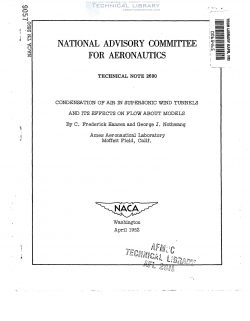naca-tn-2690
- Version
- 121 Downloads
- 1.63 MB File Size
- 1 File Count
- January 17, 2017 Create Date
- January 17, 2017 Last Updated
National Advisory Committee for Aeronautics, Technical Notes - Condensation of Air in Supersonic Wind Tunnels and Its Effects on Flow About Models

Results of an investigation of condensation phenomena in supersonic.
wind tunnels are presented. Lower and upper limits for the degree of
supersaturation attainable before the onset of condensation of air are
discussed. The upper limit is derived from the Becker-Daring theory of
self—nucleation using a surface tension corrected for draplet size. The
lower limit is calculated from the saturation vapor pressure of air.
Experimental data Obtained in the Ames 10- by lh-inch supersonic wind
tunnel and a l- by l. h—inch supersonic nozzle indicate that silica gel
particles or small amounts of water vapor in an air stream will initiate
condensation near the lower limit. Tests with the l- by l.h-inch super-
sonic nozzle indicate that dry air and nitrogen may achieve considerable
supersaturation before condensation occurs. However, relatively elabo-
rate means of air purification are required to attain this super-
saturation; thus, increasing the stagnation temperature so that the
expanded stream flow is subsaturated still appears to be the most prac-
tical means of Obtaining substantial increase in the Mach number of
condensation~free flow in wind tunnels.
A method is presented for calculating the properties of a stream
containing a small fraction of condensed air. By use of this method, it
is found that evaporation of condensed phase may change the stream
properties appreciably in the compressionO flow regions about models.
Pressures measured on the surface of a 10° Wedge substantiate these
findings.
Scattering of light from droplets of condensed phase is exploited
to demonstrate the extent of condensation in supersonic air streams and
in the flow about models.
Condensation phenomena were encountered early in supersonic research
when the usual mixtures of water vapor and air taken from the atmosphere
were expanded beyond the water-vapor saturation conditions in supersonic
wind tunnels. Condensation of the vapor-phase water was found to result
in undesirable condensation shocks (see, e.g., reference 1), but these
could be eliminated by drying the air supply.
In extending the range of supersonic research to higher Mach numbers,
the problem of condensation in wind tunnels is re-encountered, since
saturation conditions of the air itself may be reached or exceeded.
Bogdonoff and Lees (reference 2) investigated this problem and, finding
no shock discontinuity in flow with conditions theoretically exceeding
saturation, concluded that condensation of air did not occur. Later,
Becker (reference 3) presented evidence from the Langley ll—inch hyper—
sonic wind tunnel that condensation of air may occur as a gradual process
without causing a shock and that the process is initiated when static
stream properties are near saturation conditions. Wegener, Stollenwerk,
Reed, and Lundquist (reference 4) and Buhler (reference 5) have reported
similar results, although somewhat different degrees of supersaturation
were apparently attained.
| File | Action |
|---|---|
| naca-tn-2690 Condensation of Air in Supersonic Wind Tunnels and Its Effects on Flow About Models.pdf | Download |

Comment On This Post